| Pages:
1
2 |
David K
Honored Nomad
        
Posts: 65364
Registered: 8-30-2002
Location: San Diego County
Member Is Offline
Mood: Have Baja Fever
|
|
1966 Photos vs. 2009 Photos at the same place: How little has changed in the desert!
The funnest part of this discovery is comparing the photos!
There were only 2 shown in the July, 1966 issue of Desert Magazine and none other were in the box of old photos from Choral Pepper's collection, I
have.
We had the one photo of Bruce Barron and the wall, with us up there... to help get the angle right, as I wanted to try and be in the same place as
Bruce was, 43 years ago... I got close!
The other photo of Bruce by rock circles on top of the mountain, I was a bit farther away than was Choral. However, with my camera edit feature... I
got close to simulating the same.
Notice the rocks are matched... but how little the Old Man Cactus has grown in 43 years:
Feb., 1966:
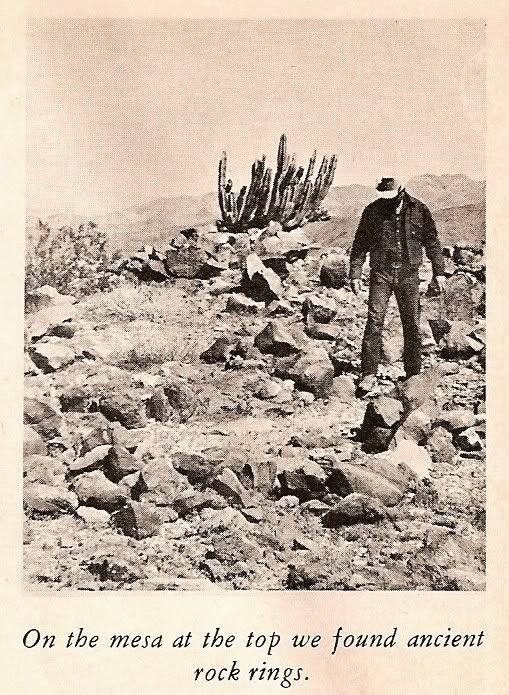
--------------------------------------------------------------------------------------
Jan., 2009:
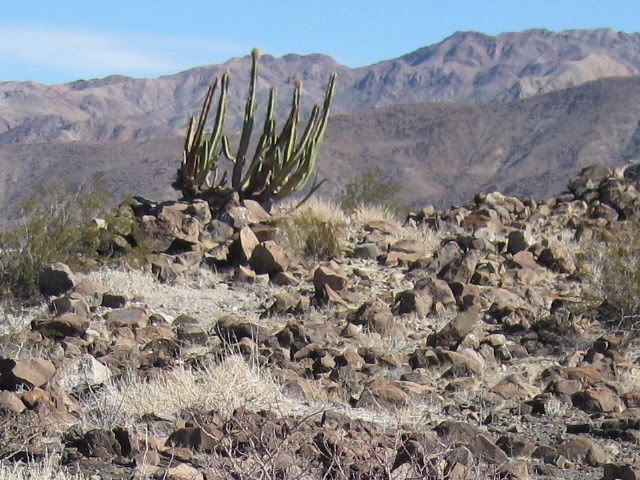
=====================================================
The wall photos 1966 vs. 2009:
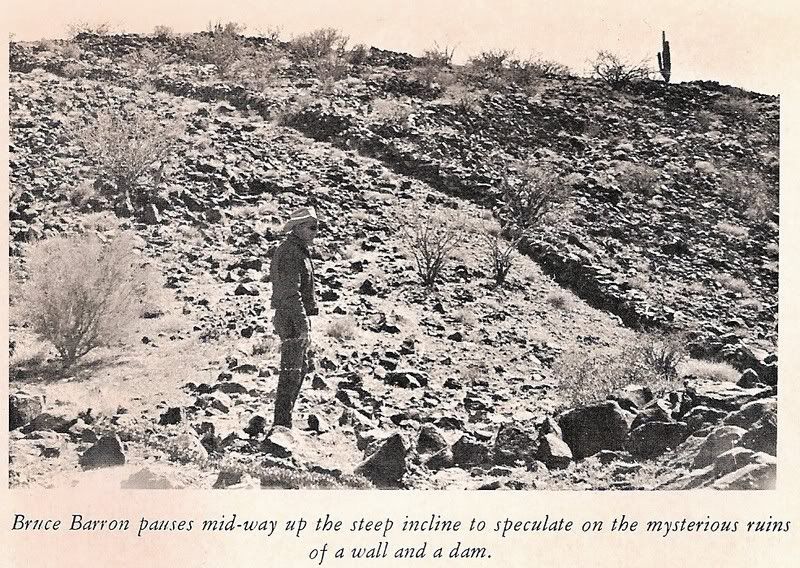

The cardon, ocotillos and other plants are so slightly changed in nearly half a century! Make one wonder how old they are?!
[Edited on 1-18-2009 by David K]
|
|
|
Natalie Ann
Ultra Nomad
    
Posts: 2819
Registered: 8-22-2003
Location: Berkeley
Member Is Offline
|
|
How very interesting - these comparison photos, David.
Although I've considered the age of the various desert plants, how slowly they grow... I'd never really considered what that meant in terms of
landscape when mankind does not make changes to it. Those photos look as if you literally time-traveled.
Thanks for taking the time to go there and set up the shots 'n all.
Nena
Edit: Actually if you time-traveled it didn't take any time at all  ,
but thank you anyway. ,
but thank you anyway.
[Edited on 1-18-2009 by Natalie Ann]
Be yourself, everyone else is already taken.
.....Oscar Wilde
|
|
|
Barry A.
Select Nomad
      
Posts: 10007
Registered: 11-30-2003
Location: Redding, Northern CA
Member Is Offline
Mood: optimistic
|
|
Something I have often noticed when viewing "before and after" photos in the West is how much "lusher" the vegetation appears to be now as opposed to
50, 100, or 150 years ago.
This is really apparent in the 1869 and 1871 set of photos of John Wesley Powell's boat journey down the Green River in Wyoming and Utah, as compared
to the same pictures today.
The west of yesteryear was much more sparse in vegetation than today, at least in most of the photos that I have seen.
We tend to think that man has raped the western landscape during the past 150 years, but really that is not so much apparent when you view these
photos-----in fact just the opposite.
Great job, David.
Barry
|
|
|
Bob H
Elite Nomad
     
Posts: 5867
Registered: 8-19-2003
Location: San Diego
Member Is Offline
|
|
David, love the comparison shots a lot! I can see that the cactus in the first shot has changed a bit... I think some of the big branches back then
have fallen and the new shot shows new branches surrounding where the center of the original cactus stood. I could be halucinating though... haha. I
see very little change in the rocks, but there are some differences.
Great shots... I really enjoyed looking at them.
Thanks,
Bob H
|
|
|
jeans
Super Nomad
   
Posts: 1059
Registered: 9-16-2002
Member Is Offline
Mood: Encantada
|
|
In the first set of pictures, the mountains sure grew a lot 
Mom always told me to be different - Now she says...Not THAT different
|
|
|
Paulina
Ultra Nomad
    
Posts: 3812
Registered: 8-31-2002
Location: BCN
Member Is Offline
|
|
| Quote: | Originally posted by jeans
In the first set of pictures, the mountains sure grew a lot 
|
Jeans,
Good eye! I didn't notice how they've grown as tall as the Old Man Cactus until you brought that to our attention!
jk David!
P<*)))>{
\"Well behaved women rarely make history.\" Laurel Thatcher Ulrich
|
|
|
David K
Honored Nomad
        
Posts: 65364
Registered: 8-30-2002
Location: San Diego County
Member Is Offline
Mood: Have Baja Fever
|
|
Jeans, my photo was taken much further away than Choral's... I zoomed in to match the rock size as close as possible to match the two photos up... I
did that here with the camera.
I may do a side by side layout and label the prominent rocks (a/a, b/b, etc.) for fun!
|
|
|
Sharksbaja
Elite Nomad
     
Posts: 5814
Registered: 9-7-2004
Location: Newport, Mulege B.C.S.
Member Is Offline
|
|
Were you able to zoom in on that varnish on the placed stones. I know what you ate talking about but I'd like to learn more about that phenomenon. Do
the rocks leech out the "varnish" according to their relative positioning or placement or is it a mineralization that is oriented by sunlight or ?? Do
you have some close-ups that show the stuff?
Now don't get technical on me! I appreciate your eye on those pics though. It
looks untouched since the two sets were taken up there. I appreciate your eye on those pics though. It
looks untouched since the two sets were taken up there.
DON\'T SQUINT! Give yer eyes a break!
Try holding down [control] key and toggle the [+ and -] keys
Viva Mulege!
Nomads\' Sunsets
|
|
|
David K
Honored Nomad
        
Posts: 65364
Registered: 8-30-2002
Location: San Diego County
Member Is Offline
Mood: Have Baja Fever
|
|
| Quote: | Originally posted by Sharksbaja
Were you able to zoom in on that varnish on the placed stones. I know what you ate talking about but I'd like to learn more about that phenomenon. Do
the rocks leech out the "varnish" according to their relative positioning or placement or is it a mineralization that is oriented by sunlight or ?? Do
you have some close-ups that show the stuff?
Now don't get technical on me! I appreciate your eye on those pics though. It
looks untouched since the two sets were taken up there. I appreciate your eye on those pics though. It
looks untouched since the two sets were taken up there. |
Here is a good photo of the wall, with my hat...
I will dig up some info on desert varnish...
Choral Pepper says this (in the Diaz Grave chapter):
They lifted a rock and turned it over. It was dark on the top, light colored underneath. The dark coating acquired by rocks in the desert is called
desert varnish. It is caused by a capillary action of the sun drawing moisture out of the rock. The dark deposit is left from minerals in the water.
In an arid region where rainfall is practically nil, desert varnish takes hundreds of years to form. The fact that these rocks were all coated by
desert varnish on the top indicated that they had remained in their positions for a very, very long time.
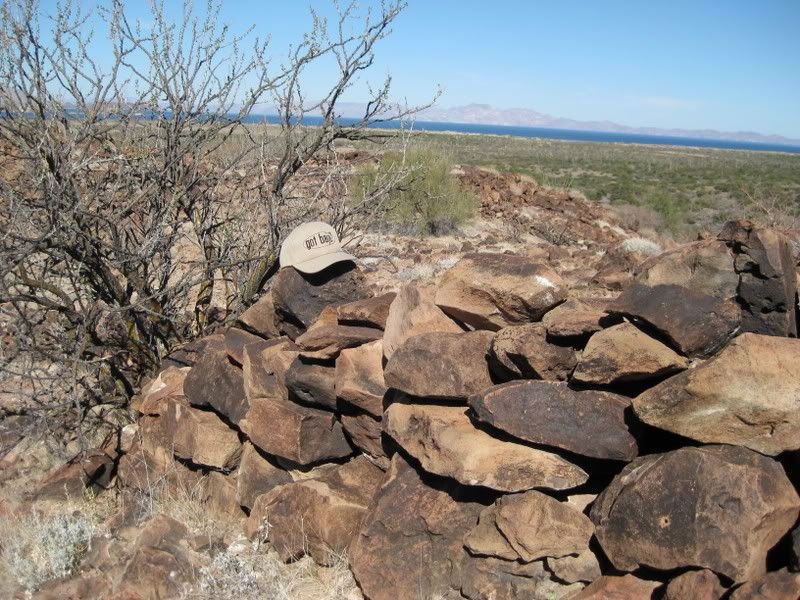
Neal Johns says this:
Desert varnish is clay and iron/manganese oxides deposited by a complex bacterial process. Ronald Dorn has done a lot of work over the decades dating
petros by analyzing these deposits.
On the Internet is a ton of info on desert varnish.
Here is a good link (to Desert USA) about the subject:
http://www.desertusa.com/magdec97/varnish/dec_varnish.html
[Edited on 1-18-2009 by David K]
|
|
|
Skipjack Joe
Elite Nomad
     
Posts: 8088
Registered: 7-12-2004
Location: Bahia Asuncion
Member Is Offline
|
|
Thank you and Neal Johns for the link on Desert Varnish. It helped explain a lot of what I had been seeing over the years. Personally I don't like the
stuff very much though. The rocks around Joshua Tree, which seem to have less desert varnish and look more quartz-like, are more beautiful. But that's
just me.
I hope you tipped Neal with a Mountain Dew for the information  
[Edited on 1-18-2009 by Skipjack Joe]
|
|
|
heike
Junior Nomad

Posts: 79
Registered: 4-28-2006
Location: Los Barriles
Member Is Offline
|
|
Thanks for the great pics! Very interesting........
|
|
|
David K
Honored Nomad
        
Posts: 65364
Registered: 8-30-2002
Location: San Diego County
Member Is Offline
Mood: Have Baja Fever
|
|
De nada...
Yah, Neal loves his Dew!

[Edited on 1-18-2009 by David K]
|
|
|
Skipjack Joe
Elite Nomad
     
Posts: 8088
Registered: 7-12-2004
Location: Bahia Asuncion
Member Is Offline
|
|
I wish he would post more often.
He's knowledgeable and funny at the same time. And he doesn't take himself too seriously.
|
|
|
Paulina
Ultra Nomad
    
Posts: 3812
Registered: 8-31-2002
Location: BCN
Member Is Offline
|
|
| Quote: | Originally posted by Skipjack Joe
I wish he would post more often.
He's knowledgeable and funny at the same time. And he doesn't take himself too seriously. |
Ditto.
That's why he's my #1 H.I.W. 
P.<*)))>{
\"Well behaved women rarely make history.\" Laurel Thatcher Ulrich
|
|
|
Mexitron
Ultra Nomad
    
Posts: 3397
Registered: 9-21-2003
Location: Fort Worth, Texas
Member Is Offline
Mood: Happy!
|
|
Nice photo comparison! Humphrey had a heck of a time trying to tell the ages of Cirios since time comparison photos sometimes showed little growth. I
imagine that most desert plants are older than what is generally believed.
In the photo of the rock wall the desert varnish is not consistent--that is some of the rocks don't have the varnish but should...that could bring the
age back into the realm of the mission era possibly. I think though that I will have to investigate this site personally and since it looks quite hot
in that area will have to bring lots of cerveza in the medicine kit to stave off the heat.
|
|
|
David K
Honored Nomad
        
Posts: 65364
Registered: 8-30-2002
Location: San Diego County
Member Is Offline
Mood: Have Baja Fever
|
|
Point by point '66 to '09:
I used the letters A through S... Choral took the photo much closer than I and and she was to the right.
Note the angle of points C and B and C and O.
Very interesting... and fun! (well for me, anyway!)
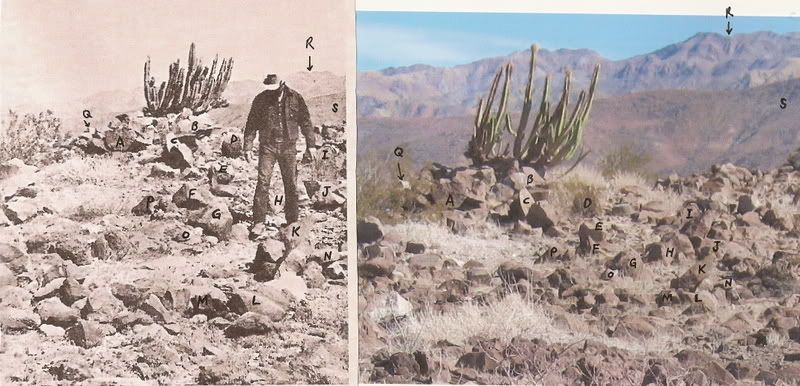
[Edited on 1-18-2009 by David K]
|
|
|
Bob H
Elite Nomad
     
Posts: 5867
Registered: 8-19-2003
Location: San Diego
Member Is Offline
|
|
Wow, the side by side reference is fantastic. I still think that the cactus has totally changed over time. But the rock identification letters are
just great!
Bob H
|
|
|
David K
Honored Nomad
        
Posts: 65364
Registered: 8-30-2002
Location: San Diego County
Member Is Offline
Mood: Have Baja Fever
|
|
Thanks Bob... I have a better quality image to use than gets posted on Nomad... So, I was careful that the pairs were the same in each case... Cool
stuff. Yes, the cactus has grown... but that's all it has, in 43 years?
[Edited on 1-19-2009 by David K]
|
|
|
Taco de Baja
Super Nomad
   
Posts: 1913
Registered: 4-14-2004
Location: Behind the Orange Curtain, CA
Member Is Offline
Mood: Dreamin' of Baja
|
|
Desert Varnish
I agree with Mexitron, a personal site visit is in order!
I also see many rocks in the wall that do not have varnish or are partially varnished In fact, on some of them you can see where the rock was buried
and only the original portion of the rock that was exposed to the elements for 1,000 of years is stained with varnish, while the previously buried
portion is not. I also bet that if you looked some of the lighter colored rocks there would be varnish on their current bottoms.
I believe the only reason the wall rocks have varnish is because the rocks that were used had varnish on them to begin with. It should not, and can
not, be used as a dating technique for the wall. It is my understanding that varnish takes 1,000 not hundreds of years to form. Hence the reason the
huge geoglyphs made by the Native Americans in the Mojave, by moving the varnished pebbles on the alluvial fans, are still visible. As are the tracks
made by the idiots who did doughnuts their trucks and motorcycles around and through the glyphs. Same reason petroglyphs are still visible, If varnish
could be formed in a couple 100 years, all the petroglyphs would be….well...history…
Truth generally lies in the coordination of antagonistic opinions
-Herbert Spencer
|
|
|
Taco de Baja
Super Nomad
   
Posts: 1913
Registered: 4-14-2004
Location: Behind the Orange Curtain, CA
Member Is Offline
Mood: Dreamin' of Baja
|
|
An interesting read on desert varnish:
The Origin of Desert Varnish
It's a large 8MB PDF file, so it will take a while to download if you have a slow connection...
| Quote: | The growth rates of rock varnish vary from <1 to 40 micrometers per thousand years on subaerially exposed rock surfaces and rarely reach
thicknesses >200 micrometers, regardless of age. The primary components which make up desert varnish are clays (nearly 70%) and iron and manganese
oxides that are derived from air-borne dust and other sources external to the underlying rock.
Since detailed studies of desert varnish began in the 1950s, the mechanism of varnish formation was not well nderstood. Initially, it was thought
that desert varnish was precipitated physiochemically. Recent studies have noted the close association between microorganisms and varnish formation,
but a causal role of this biological activity has yet to be affirmed. |
Truth generally lies in the coordination of antagonistic opinions
-Herbert Spencer
|
|
|
| Pages:
1
2 |

